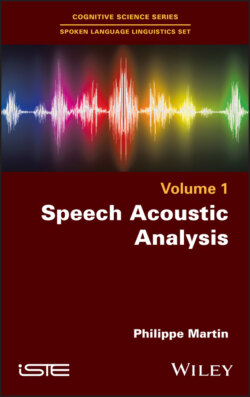Speech Acoustic Analysis

Реклама. ООО «ЛитРес», ИНН: 7719571260.
Оглавление
Philippe Martin. Speech Acoustic Analysis
Table of Contents
List of Illustrations
List of Tables
Guide
Pages
Speech Acoustic Analysis
Preface
1. Sound. 1.1. Acoustic phonetics
1.2. Sound waves
1.3. In search of pure sound
1.4. Amplitude, frequency, duration and phase. 1.4.1. Amplitude
1.4.2. Frequency
1.4.3. Duration
1.4.4. Phase
1.5. Units of pure sound
1.6. Amplitude and intensity
1.7. Bels and decibels
1.8. Audibility threshold and pain threshold
1.9. Intensity and distance from the sound source
1.10. Pure sound and musical sound: the scale in Western music
1.11. Audiometry
1.12. Masking effect
1.13. Pure untraceable sound
1.14. Pure sound, complex sound
Box 1.1.The “la” war
2. Sound Conservation. 2.1. Phonautograph
2.2. Kymograph
2.3. Recording chain
2.3.1. Distortion of magnetic tape recordings
2.3.2. Digital recording
2.4. Microphones and sound recording
2.5. Recording locations
2.6. Monitoring
2.7. Binary format and Nyquist–Shannon frequency
2.7.1. Amplitude conversion
2.7.2. Sampling frequency
2.8. Choice of recording format. 2.8.1. Which sampling frequency should be chosen?
2.8.2. Which coding format should be chosen?
2.8.3. Recording capacity
2.9. MP3, WMA and other encodings
Box 2.1.The MP3 code on T-shirts
3. Harmonic Analysis. 3.1. Harmonic spectral analysis
3.2. Fourier series and Fourier transform
3.3. Fast Fourier transform
3.4. Sound snapshots
3.5. Time windows
3.6. Common windows
3.7. Filters
3.8. Wavelet analysis. 3.8.1. Wavelets and Fourier analysis
3.8.2. Choice of the number of cycles
4. The Production of Speech Sounds. 4.1. Phonation modes
4.2. Vibration of the vocal folds
4.3. Jitter and shimmer
4.4. Friction noises
4.5. Explosion noises
4.6. Nasals
4.7. Mixed modes
4.8. Whisper
4.9. Source-filter model
5. Source-filter Model Analysis. 5.1. Prony’s method – LPC
5.1.1. Zeros and poles
5.2. Which LPC settings should be chosen? 5.2.1. Window duration?
5.2.2. What order for LPC?
5.3. Linear prediction and Prony’s method: nasals
5.4. Synthesis and coding by linear prediction
Box 5.1.The rediscovery of Prony. East Coast versus West Coast
6. Spectrograms. 6.1. Production of spectrograms
6.2. Segmentation. 6.2.1. Segmentation: an awkward problem (phones, phonemes, syllables, stress groups)
6.2.2. Segmentation by listeners
6.2.3. Traditional manual (visual) segmentation
6.2.4. Phonetic transcription
6.2.5. Silences and pauses
6.2.6. Fricatives
6.2.7. Occlusives, stop consonants
6.2.8. Vowels
6.2.9. Nasals
6.2.10. The R
6.2.11. What is the purpose of segmentation?
6.2.12. Assessment of segmentation
6.2.13. Automatic computer segmentation
6.2.14. On-the-fly segmentation
6.2.15. Segmentation by alignment with synthetic speech
6.2.16. Spectrogram reading using phonetic analysis software
6.3. How are the frequencies of formants measured?
6.4. Settings: recording
Box 6.1.The myth of the voiceprint
7. Fundamental Frequency and Intensity. 7.1. Laryngeal cycle repetition
7.2. The fundamental frequency: a quasi-frequency
7.3. Laryngeal frequency and fundamental frequency
7.4. Temporal methods
7.4.1. Filtering
7.4.2. Autocorrelation
7.4.3. AMDF
7.5. Frequency (spectral) methods
7.5.1. Cepstrum
7.5.2. Spectral comb
7.5.3. Spectral brush
7.5.4. SWIPE
7.5.5. Measuring errors of F0
7.6. Smoothing
7.7. Choosing a method to measure F0
7.8. Creaky voice
7.9. Intensity measurement
7.10. Prosodic annotation
7.10.1. Composition of accent phrases
7.10.2. Annotation of stressed syllables, mission impossible?
7.10.3. Framing the annotation of stressed syllables
7.10.4. Pitch accent
7.10.5. Tonal targets and pitch contours
7.11. Prosodic morphing
7.11.1. Change in intensity
7.11.2. Change in duration by the Psola method
7.11.3. Slowdown/acceleration
7.11.4. F0 modification
Box 7.1.The Psola mystery
7.11.5. Modification of F0 and duration by phase vocoder
8. Articulatory Models. 8.1. History
8.2. Single-tube model
8.3. Two-tube model
8.4. Three-tube model
8.5. N-tube model
Appendix. A.1 Definition of the sine, cosine, tangent and cotangent of an angle α
A.2 Variations of sine, cosine, tangent and cotangent as a function of angle α
References
Index. A, B
D
F
H, I
M, N
O, P
Q, R, S
T, V
WILEY END USER LICENSE AGREEMENT
Отрывок из книги
Spoken Language Linguistics Set
.....
Volume 1
Philippe Martin
.....